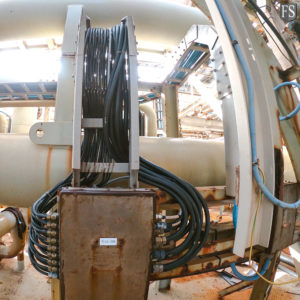Flame retardant cable
Simply put, fire rated cables are designed to resist the spread of fire in new venues. Flame retardant cables are not used in applications where circuit integrity must be maintained even under fire conditions. On the other hand, all other circuits use fire resistant cables, so in the event of a fire, they stop the fire from spreading.
Because the flame retardant layer of a fire retardant cable can usually be wound directly onto the wire using various fire retardant materials. If the wrapping layer of the cable is glued glass tape or mica tape, the insulating material will not be in direct contact with the flame and will burn when burned, but will heat up and melt, since the wrapping layer has certain fire retardant properties.
Armored electrical cable
In addition, if the cable is armored, the stress and strain created by the steel tape will also propagate to the refractory layer when the temperature changes, thereby reducing the refractory performance and causing more damage to the refractory layer. The fire-resistant cable produces less smoke when it burns, especially when refractory materials are used to make the flame retardant properties fire-resistant, and when the fire is accompanied by water spraying, the cable can still maintain line operation. This subjects the cable to the same conditions as all fire rated building materials (such as fire doors) but adds the requirement that the cable maintain circuit integrity during a fire and after the hose has been used.
Cable voltage rating
As with most cables, the first thing to consider is the voltage rating, which is what the cable can withstand. Not only are these cables capable of withstanding ignition and preventing the spread of flames, but they are also capable of continuing to operate normally for several hours while the fire rages around them, making them ideal for use in critical security applications. Typically, these cables are used wherever there is a need to protect the lives of people and ensure the operation of critical circuits to ensure a safe exit.
PEWC adheres to the traditional style of researching, designing and manufacturing flame retardant and heat resistant cables, using special materials, first-class technology and strict quality control to ensure social protection. Its performance in or without fire is largely dependent on proper construction, quality materials and standards set by international organizations.
Heat-resistant cable
Heat or high temperature resistant cable does not guarantee performance when exposed to fire, but it can withstand higher temperatures without melting. Using heat-resistant materials such as glass filament, FEP, PFA, ETFE, Besilen® (silicone) and halogen-free core and sheath material SABIX®, these heat-resistant cables can be used at the highest temperatures. As a new technology, as a representative of fire-resistant cables, the principle of the cable is that the cable can form a self-supporting ceramic body in the flame, which has a certain resistance and can be used for flames at temperatures between 650 and 1000 degrees Celsius.
Mineral insulated cable
At present, with the continuous development of various industries, it is necessary to use wires and cables in many areas. In addition, mineral insulated cable has better performance than flame retardant cables made with copper core, copper sheath, magnesium oxide insulating material processing, called MI cable (mineral insulated cable). Its fire resistance, combined with the fact that drywall was much cheaper than MI fire cables (the only other viable alternative that hadn’t been concrete for many years), made drywall fencing the traditional and obvious choice for electrical safety fire circuits. This is the outermost part of the cable that can come into contact with fire.



